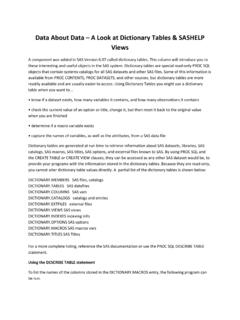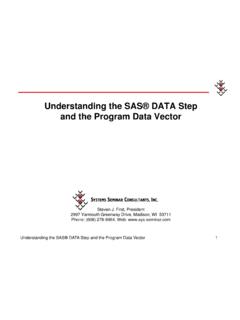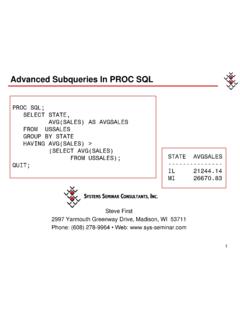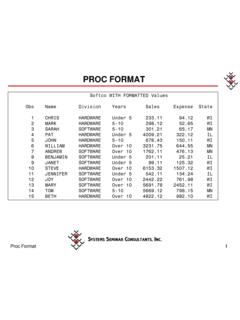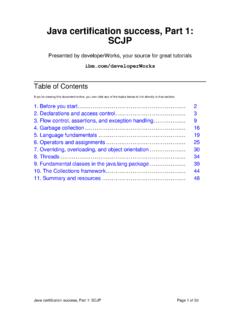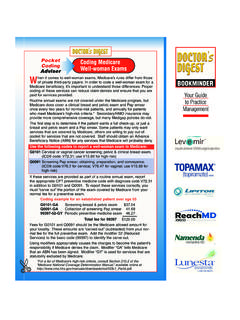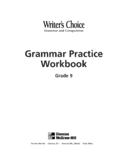Transcription of Converting Numeric and Character Data
1 1 Converting Numeric Variables and Character Variables in SASR andall Reilly; Covance Clinical Pharmacology; Madison, WIINTRODUCTIONThis paper gives a general understanding of how to convert Numeric and Character SAS variables Numeric VARIABLES TO Character VARIABLESThe simpliest way to convert Numeric data to Character data is using the PUT function. Converting numbers tocharacters is quite you have only whole numbers use the following statement:charvar = STRIP(PUT(numvar, 8.));This will output the Character values as whole numbersExample:FROMTO77696934341212**You should always format the new Character variables ( format charvar $8.) and you should always strip the newvariable since Numeric data is right justified and characters are left justified. If you don t you may run into thefollowing:format numvar 8. charvar $ numvar is not justified you will, in most cases get no data populating charvar. In other cases you will only getpartial : Numeric $5 Positions - 12345678 Positions - **If you have Numeric data (subject numbers for example).
2 If you want to convert to a Character variable and still havethe sort sequentially then you must zero fill the = STRIP(PUT(numvar, z2.));Example:FROMTO21012023031111121226 26If you tried to convert the data using the first example:charvar = STRIP(PUT(numvar, 8.));The ouput will be a Character variable, which will sort as (remember a Character 1 in the first position sorts before acharacter 2):Example:FROMTO111111121222262633**If you have a variety of Numeric data depending on how you want the data stored in a Character variables you canconvert the Numeric data a variety of ways:1) if you just want to store the raw values you can use the BEST = STRIP(PUT(numvar, best32.));This will store the data exactly as you see the Numeric ) if you want to add trailing zeroes to the data you use the following:charvar = STRIP(PUT(numvar, ));This will store the data out to 2 decimal Character VARIABLES TO Numeric VARIABLESThe simpliest way to convert Numeric data to Character data is using the INPUT you have only Numeric data as an integer in a Character variable use the following statement:numvar = INPUT(charvar, 8.
3 ;Example:FROMTO77696934341212 Remember: the Numeric data is right justified and characters are left justified.**NOTE Do not ever use this statement to convert a Character to a Numeric : numvar = charvar * 1;SAS will convert it but you will have to deal the FUZZ factor and other potential problems in your data . If you wantto know more about the FUZZ factor then consult a SAS manual it can be a very difficult function to understandYou will get the following in the log:NOTE: Character values have been converted to Numeric values at the places given by:(Line):(Column).**Because a Numeric variable does not display trailing zeroes in the output. The easiest thing to do when you don tknow how the Numeric data is stored in a Character variable is:numvar = INPUT(charvar, best32.); **Because a Character variable can hold both alpha and Numeric data sometimes it make it difficult to convert the you have any non- Numeric Character in the Character variable the output will be missing and your log will contain aNOTE: Invalid data message everytime you have a non- Numeric Character in your data .
4 So you could get 10,20, 50 or more notes in your solve this problem you can use the modifiers? and ??. Both modifiers suppress the note message in your errorlog, but ?? modifier also resets the automatic error variable to 0, eliminating the error condition flagged because ofthe invalid data . In both cases the offending variable will still be set to missing, but our log has been cleaned = INPUT(charvar, ?? best32.); VARIABLES USING PROC FORMATWhen Converting variables to a new variables use the following table to figure out which INPUT or PUT statementyou should use and how your PROC FORMAT statement should be written: Converting :INPUT/PUT statementPROC FORMATC haracter to numericINPUTINVALUE $fmtCharacter to characterPUTVALUE $fmtNumeric to characterPUTVALUE fmtNumeric to numericINPUTINVALUE fmtCONVERTING A Character VARIABLE TO A NEW Character VARIABLE USINGPROC FORMATYou can also convert a Character variable to a new Character variable using PROC FORMAT.
5 If you have thefollowing case:You want to change abbreviations to the full ) You will need a PROC FORMAT statement52) You need a VALUE statement along with a name for your format ($bdsysf). When Converting from Character tocharacter the format name needs to start with a $. Also close the VALUE statement with a semicolon (;). It isusually best to keep the format name less than or equal to 8 characters including the $ .proc format; value $bdsysf 'BODY' = 'BODY AS A WHOLE' 'CV' = 'CARDIOVASCULAR' 'DIG' = 'DIGESTIVE' 'ENDO' = 'ENDOCRINE' 'HAL' = 'HEMIC AND LYMPHATIC' 'MAN' = 'METABOLIC AND NUTRITIONAL DISORDERS' 'MS' = 'MUSCULOSKELETAL' 'NER' = 'NERVOUS' 'RES' = 'RESPIRATORY' 'SKIN' = 'SKIN AND APPENDAGES' 'SS' = 'SPECIAL SENSES' 'UG' = 'UROGENITAL' Other = '**ERROR**' ;run;3) The following statement will convert the below:aesoctxt = STRIP(PUT(STRIP(aesoc), $ bdsysf.
6 ; (Remember to format the new variable aesoctxtin your data step).Example:FROMTOUGUROGENITALNERNERVO USSSS**ERROR**DIGDIGESTIVE**The statementOther = '**ERROR**'will convert anything that doesn t match any previous values to '**ERROR**' since it is a special value. If you don tuse this statement then any unformatted value will come back unchanged. Special values also include LOW :FROMTOUGUROGENITALNERNERVOUSSSSSSSDIGDI GESTIVE6 Notice that the SSS did not convert to a long name because it isn t in the PROC FORMAT.**The DEFAULT option: When using PROC FORMAT the maximum length of the output value depends on the lengthof the first formatted value. In the above case the first formatted value is 'BODY AS A WHOLE' which is 15character long. This means that anything longer than 15 characters will be output as 15 characters, so'METABOLIC AND NUTRITIONAL DISORDERS' will be output as 'METABOLIC AND NU .The solution is to use the DEFAULT=length option.
7 The statement value $bdsysf should be written as value$bdysysf (DEFAULT=50).**In addition your PROC FORMAT statement can use ranges or lists.:proc format; value $sigfmt 'H' = 'High' 'L' = 'Low' 'U' = 'Unknown' '*' , A = 'Abnormal' 'N' = 'Normal' ;run;proc format; value $regfmt 'A'- F = 'Monday' 'G'- L = 'Tuesday' 'M'- R = 'Wednesday' S - Z = Thursday ;run; Converting A Character VARIABLE TO A Numeric VARIABLE USING PROCFORMATC onverting a Character variable to a Numeric variable is similar to the above example except you use an INPUT statement instead of a PUT statement. In your PROC FORMAT you use INVALUE instead of format;invalue $rtdfmt 'NOT RELATED' = 1 'POSSIBLE' = 2 'PROBABLE' = 3 'DEFINITE' = 4 'UNKNOWN' = 57 Other = 9999 ;run;aertdnum = INPUT(STRIP(UPCASE(aertd)), $rtdfmt.)
8 ;**A few useful options that the INVALUE statement has that the VALUE statement does not are the options JUST you rewrite the statement:invalue rtdfmt as invalue rtdfmt (JUST UPCASE)You can write the conversion statement asaertdnum = INPUT(aertd, $rtdfmt.);since the variable aertd is stripped and upcased by the options JUST and A Numeric VARIABLE TO A Character VARIABLE USING PROCFORMATC onverting a Numeric variable to a Character variable is almost the same as Converting a Character variable to a newcharacter variable. The only exception is that the value name (lbcat below) doesn t start with a $ ( $lbcat)and the unformatted values are not in format;value lbcat (DEFAULT =100) 1 = 'Chemistry: Metabolic Substrates' 2 = 'Chemistry: Hepatic Status Liver Function Tests' 3 = 'Chemistry: Renal Status Serum Metabolites' 4 = 'Chemistry: Serum Electrolytes' 5 = 'Chemistry: Other' 6 = 'Hematology: CBC' 7 = 'Hematology: Differential Counts' 8 = 'Hematology: Coagulation' 9 = 'Urinalysis: General' 10 = 'Urinalysis: Dipstick' 11 = 'Urinalysis: Microscopics' 12 = 'Urinalysis: Other' ; run;lbcatname = STRIP(PUT(lbcatnum, lbcat.))
9 ;**Again, remember to include a format statement in your data step ( format lbcatname $100.) and use theDEFAULT option rather than trusting that SAS will create everything correctly for you.**You can also create a variable by checking for Numeric ranges and output the result depending on which group thedata falls in. This can be useful when trying to group data in different groups so that you format;value crclfmt (default=10) LOW- <30 = Mild 30 60 = Moderate >60 - HIGH = Severe ;run; Converting A Numeric VARIABLE TO A NEW Numeric VARIABLE USING PROCFORMATC onverting a Numeric variable to a new Numeric variable is almost the same as Converting a Character variable to anumeric variable. The only exception is that the value name (tptnumf below) doesn t start with a $ ( $ tptnumf)and the unformatted values are not in format;invalue tptnumdc1= 02= 15= 26= 47= 68= 89= 1010= 1211= 1812= 24;run;This statement will convert a Numeric to a = INPUT(tptnum, tptnudc.)
10 ;You will get the following NOTE in your log, but it will not affect the data :NOTE: Numeric values have been converted to Character values at the places given by:9 OTHER TYPES OF CONVERSIONS USING PROC FORMATYou can also use a PICTURE statement in PROC FORMAT to create or present data a certain way. The PICTURE statement creates formats for Numeric variables first examples are Converting SAS DATE and TIME variables. Remember a SAS DATE and TIME variable isconsidered format; picture slashdate (default=11) other='%0d/%0b/%Y' (datatype=date);run;SLASHDATE will convert a DATEx variable to DD/MON/YYYY format, which is not available in newdate $20.;newdate = STRIP(PUT(datevar, slashdate.));Example:FROM TO24 SEP2009 24/SEP/200901 JAN2010 01/JAN/201006 APR1962 06/APR/1962**proc format; picture tmfive(default=5) other='%0H:%0M' (datatype=time);run;The picture TMFIVE will give a Character time with leading zeroes.
